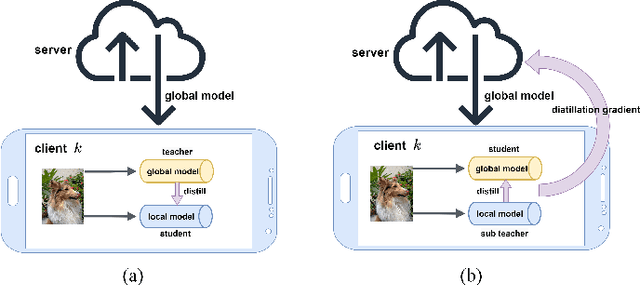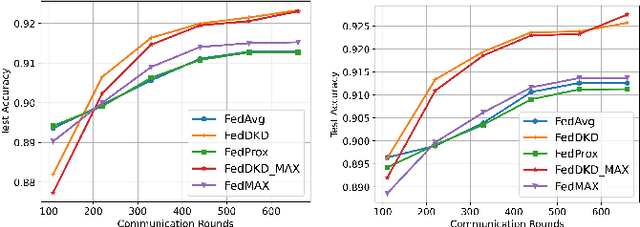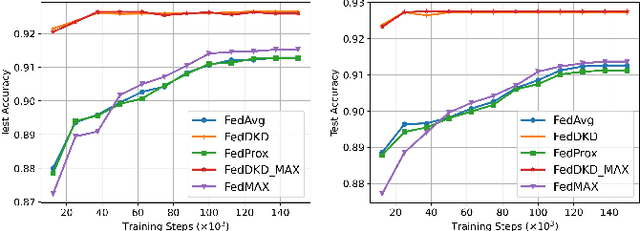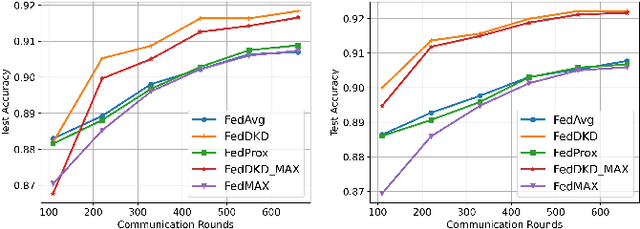Wenlian Lu
Uncertainty Quantification in Working Memory via Moment Neural Networks
Nov 21, 2024Abstract:Humans possess a finely tuned sense of uncertainty that helps anticipate potential errors, vital for adaptive behavior and survival. However, the underlying neural mechanisms remain unclear. This study applies moment neural networks (MNNs) to explore the neural mechanism of uncertainty quantification in working memory (WM). The MNN captures nonlinear coupling of the first two moments in spiking neural networks (SNNs), identifying firing covariance as a key indicator of uncertainty in encoded information. Trained on a WM task, the model demonstrates coding precision and uncertainty quantification comparable to human performance. Analysis reveals a link between the probabilistic and sampling-based coding for uncertainty representation. Transferring the MNN's weights to an SNN replicates these results. Furthermore, the study provides testable predictions demonstrating how noise and heterogeneity enhance WM performance, highlighting their beneficial role rather than being mere biological byproducts. These findings offer insights into how the brain effectively manages uncertainty with exceptional accuracy.
Towards free-response paradigm: a theory on decision-making in spiking neural networks
Apr 16, 2024Abstract:The energy-efficient and brain-like information processing abilities of Spiking Neural Networks (SNNs) have attracted considerable attention, establishing them as a crucial element of brain-inspired computing. One prevalent challenge encountered by SNNs is the trade-off between inference speed and accuracy, which requires sufficient time to achieve the desired level of performance. Drawing inspiration from animal behavior experiments that demonstrate a connection between decision-making reaction times, task complexity, and confidence levels, this study seeks to apply these insights to SNNs. The focus is on understanding how SNNs make inferences, with a particular emphasis on untangling the interplay between signal and noise in decision-making processes. The proposed theoretical framework introduces a new optimization objective for SNN training, highlighting the importance of not only the accuracy of decisions but also the development of predictive confidence through learning from past experiences. Experimental results demonstrate that SNNs trained according to this framework exhibit improved confidence expression, leading to better decision-making outcomes. In addition, a strategy is introduced for efficient decision-making during inference, which allows SNNs to complete tasks more quickly and can use stopping times as indicators of decision confidence. By integrating neuroscience insights with neuromorphic computing, this study opens up new possibilities to explore the capabilities of SNNs and advance their application in complex decision-making scenarios.
Efficient Combinatorial Optimization via Heat Diffusion
Mar 14, 2024Abstract:Combinatorial optimization problems are widespread but inherently challenging due to their discrete nature.The primary limitation of existing methods is that they can only access a small fraction of the solution space at each iteration, resulting in limited efficiency for searching the global optimal. To overcome this challenge, diverging from conventional efforts of expanding the solver's search scope, we focus on enabling information to actively propagate to the solver through heat diffusion. By transforming the target function while preserving its optima, heat diffusion facilitates information flow from distant regions to the solver, providing more efficient navigation. Utilizing heat diffusion, we propose a framework for solving general combinatorial optimization problems. The proposed methodology demonstrates superior performance across a range of the most challenging and widely encountered combinatorial optimizations. Echoing recent advancements in harnessing thermodynamics for generative artificial intelligence, our study further reveals its significant potential in advancing combinatorial optimization.
Let LLMs Take on the Latest Challenges! A Chinese Dynamic Question Answering Benchmark
Mar 02, 2024Abstract:How to better evaluate the capabilities of Large Language Models (LLMs) is the focal point and hot topic in current LLMs research. Previous work has noted that due to the extremely high cost of iterative updates of LLMs, they are often unable to answer the latest dynamic questions well. To promote the improvement of Chinese LLMs' ability to answer dynamic questions, in this paper, we introduce CDQA, a Chinese Dynamic QA benchmark containing question-answer pairs related to the latest news on the Chinese Internet. We obtain high-quality data through a pipeline that combines humans and models, and carefully classify the samples according to the frequency of answer changes to facilitate a more fine-grained observation of LLMs' capabilities. We have also evaluated and analyzed mainstream and advanced Chinese LLMs on CDQA. Extensive experiments and valuable insights suggest that our proposed CDQA is challenging and worthy of more further study. We believe that the benchmark we provide will become one of the key data resources for improving LLMs' Chinese question-answering ability in the future.
Learn to integrate parts for whole through correlated neural variability
Jan 01, 2024Abstract:Sensory perception originates from the responses of sensory neurons, which react to a collection of sensory signals linked to various physical attributes of a singular perceptual object. Unraveling how the brain extracts perceptual information from these neuronal responses is a pivotal challenge in both computational neuroscience and machine learning. Here we introduce a statistical mechanical theory, where perceptual information is first encoded in the correlated variability of sensory neurons and then reformatted into the firing rates of downstream neurons. Applying this theory, we illustrate the encoding of motion direction using neural covariance and demonstrate high-fidelity direction recovery by spiking neural networks. Networks trained under this theory also show enhanced performance in classifying natural images, achieving higher accuracy and faster inference speed. Our results challenge the traditional view of neural covariance as a secondary factor in neural coding, highlighting its potential influence on brain function.
Digital Twin Brain: a simulation and assimilation platform for whole human brain
Aug 02, 2023Abstract:In this work, we present a computing platform named digital twin brain (DTB) that can simulate spiking neuronal networks of the whole human brain scale and more importantly, a personalized biological brain structure. In comparison to most brain simulations with a homogeneous global structure, we highlight that the sparseness, couplingness and heterogeneity in the sMRI, DTI and PET data of the brain has an essential impact on the efficiency of brain simulation, which is proved from the scaling experiments that the DTB of human brain simulation is communication-intensive and memory-access intensive computing systems rather than computation-intensive. We utilize a number of optimization techniques to balance and integrate the computation loads and communication traffics from the heterogeneous biological structure to the general GPU-based HPC and achieve leading simulation performance for the whole human brain-scaled spiking neuronal networks. On the other hand, the biological structure, equipped with a mesoscopic data assimilation, enables the DTB to investigate brain cognitive function by a reverse-engineering method, which is demonstrated by a digital experiment of visual evaluation on the DTB. Furthermore, we believe that the developing DTB will be a promising powerful platform for a large of research orients including brain-inspiredintelligence, rain disease medicine and brain-machine interface.
Modify Training Directions in Function Space to Reduce Generalization Error
Jul 25, 2023Abstract:We propose theoretical analyses of a modified natural gradient descent method in the neural network function space based on the eigendecompositions of neural tangent kernel and Fisher information matrix. We firstly present analytical expression for the function learned by this modified natural gradient under the assumptions of Gaussian distribution and infinite width limit. Thus, we explicitly derive the generalization error of the learned neural network function using theoretical methods from eigendecomposition and statistics theory. By decomposing of the total generalization error attributed to different eigenspace of the kernel in function space, we propose a criterion for balancing the errors stemming from training set and the distribution discrepancy between the training set and the true data. Through this approach, we establish that modifying the training direction of the neural network in function space leads to a reduction in the total generalization error. Furthermore, We demonstrate that this theoretical framework is capable to explain many existing results of generalization enhancing methods. These theoretical results are also illustrated by numerical examples on synthetic data.
Probabilistic Computation with Emerging Covariance: Towards Efficient Uncertainty Quantification
May 31, 2023Abstract:Building robust, interpretable, and secure artificial intelligence system requires some degree of quantifying and representing uncertainty via a probabilistic perspective, as it allows to mimic human cognitive abilities. However, probabilistic computation presents significant challenges due to its inherent complexity. In this paper, we develop an efficient and interpretable probabilistic computation framework by truncating the probabilistic representation up to its first two moments, i.e., mean and covariance. We instantiate the framework by training a deterministic surrogate of a stochastic network that learns the complex probabilistic representation via combinations of simple activations, encapsulating the non-linearities coupling of the mean and covariance. We show that when the mean is supervised for optimizing the task objective, the unsupervised covariance spontaneously emerging from the non-linear coupling with the mean faithfully captures the uncertainty associated with model predictions. Our research highlights the inherent computability and simplicity of probabilistic computation, enabling its wider application in large-scale settings.
Toward spike-based stochastic neural computing
May 23, 2023Abstract:Inspired by the highly irregular spiking activity of cortical neurons, stochastic neural computing is an attractive theory for explaining the operating principles of the brain and the ability to represent uncertainty by intelligent agents. However, computing and learning with high-dimensional joint probability distributions of spiking neural activity across large populations of neurons present as a major challenge. To overcome this, we develop a novel moment embedding approach to enable gradient-based learning in spiking neural networks accounting for the propagation of correlated neural variability. We show under the supervised learning setting a spiking neural network trained this way is able to learn the task while simultaneously minimizing uncertainty, and further demonstrate its application to neuromorphic hardware. Built on the principle of spike-based stochastic neural computing, the proposed method opens up new opportunities for developing machine intelligence capable of computing uncertainty and for designing unconventional computing architectures.
FedDKD: Federated Learning with Decentralized Knowledge Distillation
May 02, 2022



Abstract:The performance of federated learning in neural networks is generally influenced by the heterogeneity of the data distribution. For a well-performing global model, taking a weighted average of the local models, as done by most existing federated learning algorithms, may not guarantee consistency with local models in the space of neural network maps. In this paper, we propose a novel framework of federated learning equipped with the process of decentralized knowledge distillation (FedDKD) (i.e., without data on the server). The FedDKD introduces a module of decentralized knowledge distillation (DKD) to distill the knowledge of the local models to train the global model by approaching the neural network map average based on the metric of divergence defined in the loss function, other than only averaging parameters as done in literature. Numeric experiments on various heterogeneous datasets reveal that FedDKD outperforms the state-of-the-art methods with more efficient communication and training in a few DKD steps, especially on some extremely heterogeneous datasets.
 Add to Chrome
Add to Chrome Add to Firefox
Add to Firefox Add to Edge
Add to Edge